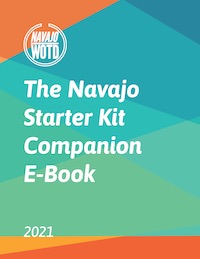dah / yah
Today, we’ll introduce two more ways to ask questions. As a general rule, da’ precedes the sentence, and ya’ follows it – but you only need to use one.
Da’ is a simple way to create a yes/no question. You would say a regular statement, like “John is going to the store,” and by attaching da’ before the entire sentence it would become “Is John going to the store?”
Ya’ means roughly, “right?” Using the same sentence as above, it would become “John is going to the store, right?”
When you say these words, some people may have a tendency to raise the inflection of the voice like you would in English. But in Navajo, keep the voice normal (don’t raise it) and people will know that you’re asking a question.
Glottal stops are abrupt stops that happen when the glottis in the throat closes briefly, stopping air from exiting through the mouth.# December 2012
